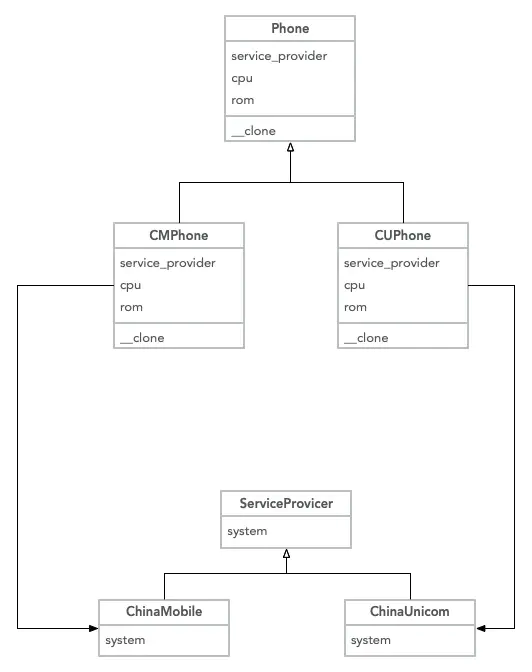Learn about the prototype pattern in PHP in one article
In the previous article " A brief discussion of the iterator pattern in PHP" we introduced the iterator pattern in PHP. This article will take you to understand the prototype pattern in PHP.

#Prototype mode is actually more vividly called clone mode. Its main behavior is to clone objects, but it also calls the cloned object the original prototype, so this pattern is named. To be honest, judging from how it is used, it feels more appropriate to call it clone mode.
Gof class diagram and explanation
GoF definition: Use prototype instances to specify the types of objects to be created, and create new objects by copying these prototypes
GoF class diagram:

##Code implementation:
abstract class Prototype
{
public $v = 'clone' . PHP_EOL;
public function __construct()
{
echo 'create' . PHP_EOL;
}
abstract public function __clone();
}class ConcretePrototype1 extends Prototype
{
public function __clone()
{
}
}
class ConcretePrototype2 extends Prototype
{
public function __clone()
{
}
}class Client
{
public function operation()
{
$p1 = new ConcretePrototype1();
$p2 = clone $p1;
echo $p1->v;
echo $p2->v;
}
}
$c = new Client();
$c->operation();p2 also has the same $v attribute. 
- The prototype mode seems to copy the same object, but please note that when copying, the __construct() method is not called, that is, when you run this code, create Only output once. This also brings out one of the biggest features of the prototype pattern-
- Reduce the overhead of creating objects. Based on the above characteristics, we can quickly copy a large number of identical objects, such as when we want to stuff a large number of identical objects into an array. If the copied objects are all value type attributes, we can modify them arbitrarily without affecting the prototype. If there are reference type variables, some processing needs to be done in the __clone() method. Otherwise, modifying the contents of the reference variables of the copied object will affect the contents of the prototype object.
How is our mobile operating system (you can also imagine the operating system of a PC) installed on the device? In fact, they are constantly copying and copying the original system. The example of Microsoft illustrates this problem very well. Microsoft was able to become an empire back then because it kept copying copies of the winodws operating system to CDs and then sold them to thousands of households (of course, there is nothing wrong with China here) . As for the Chinese market, a large number of experts have cracked Windows and copied this file continuously before installing it into our computers. This is true for the operating systems and software of various products such as mobile phones and smart devices. Unlimited copies of one development are the reason for huge profits in the software industry. After all, our system was developed on the basis of the Android native system by many engineers working day and night. Hurry up and copy it to the mobile phones that are about to be shipped! !
完整代码:https://link.juejin.cn/?target=https%3A%2F%2Fgithub.com%2Fzhangyue0503%2Fdesignpatterns-php%2Fblob%2Fmaster%2F08.prototype%2Fsource%2Fprototype.php
Prototype mode production mobile phone class diagram:
##
完整源码:https://link.juejin.cn/?target=https%3A%2F%2Fgithub.com%2Fzhangyue0503%2Fdesignpatterns-php%2Fblob%2Fmaster%2F08.prototype%2Fsource%2Fprototype-phone.php
<?php
interface ServiceProvicer
{
public function getSystem();
}
class ChinaMobile implements ServiceProvicer
{
public $system;
public function getSystem(){
return "中国移动" . $this->system;
}
}
class ChinaUnicom implements ServiceProvicer
{
public $system;
public function getSystem(){
return "中国联通" . $this->system;
}
}
class Phone
{
public $service_province;
public $cpu;
public $rom;
}
class CMPhone extends Phone
{
function __clone()
{
// $this->service_province = new ChinaMobile();
}
}
class CUPhone extends Phone
{
function __clone()
{
$this->service_province = new ChinaUnicom();
}
}
$cmPhone = new CMPhone();
$cmPhone->cpu = "1.4G";
$cmPhone->rom = "64G";
$cmPhone->service_province = new ChinaMobile();
$cmPhone->service_province->system = 'TD-CDMA';
$cmPhone1 = clone $cmPhone;
$cmPhone1->service_province->system = 'TD-CDMA1';
var_dump($cmPhone);
var_dump($cmPhone1);
echo $cmPhone->service_province->getSystem();
echo $cmPhone1->service_province->getSystem();
$cuPhone = new CUPhone();
$cuPhone->cpu = "1.4G";
$cuPhone->rom = "64G";
$cuPhone->service_province = new ChinaUnicom();
$cuPhone->service_province->system = 'WCDMA';
$cuPhone1 = clone $cuPhone;
$cuPhone1->rom = "128G";
$cuPhone1->service_province->system = 'WCDMA1';
var_dump($cuPhone);
var_dump($cuPhone1);
echo $cuPhone->service_province->getSystem();
echo $cuPhone1->service_province->getSystem(); Description:
Description:
- I printed a lot of things, but the main thing is to look at the mobile phone, that is, the __clone() method in CMPhone. We did not re-initialize a new object. At this time, the copied
- cmPhone contains the same object. Yes, this is a reference duplication problem. The reference just copies the address of the reference, they point to the same object. when
 The attributes in the service_province object in cmPhone have also changed.
The attributes in the service_province object in cmPhone have also changed. -
In CUPhone, we created a new service_province object. This time the value of the referenced object in
 cuPhone outside.
cuPhone outside. - The most important thing in prototype mode is to pay attention to the above two points, while ordinary value attributes will be copied directly and this problem will not occur. Two other concepts are involved here: Shallow copy and Deep copy
- Shallow copy means that all variables of the copied object contain the same variables as the original object. value, and all references to other objects still point to the original object
- Deep copy points the variable of the referenced object to the copied new object, not the original referenced object
- Regarding the issues of references and values, we will explain them in other articles. Please follow WeChat or Nuggets account
##Original address: https://juejin.cn/post/ 6844903942220939272Author: Hardcore Project ManagerRecommended learning: "
PHP Video Tutorial"
The above is the detailed content of Learn about the prototype pattern in PHP in one article. For more information, please follow other related articles on the PHP Chinese website!

Hot AI Tools

Undresser.AI Undress
AI-powered app for creating realistic nude photos

AI Clothes Remover
Online AI tool for removing clothes from photos.

Undress AI Tool
Undress images for free

Clothoff.io
AI clothes remover

AI Hentai Generator
Generate AI Hentai for free.

Hot Article

Hot Tools

Notepad++7.3.1
Easy-to-use and free code editor

SublimeText3 Chinese version
Chinese version, very easy to use

Zend Studio 13.0.1
Powerful PHP integrated development environment

Dreamweaver CS6
Visual web development tools

SublimeText3 Mac version
God-level code editing software (SublimeText3)

Hot Topics
 1378
1378
 52
52
 PHP 8.4 Installation and Upgrade guide for Ubuntu and Debian
Dec 24, 2024 pm 04:42 PM
PHP 8.4 Installation and Upgrade guide for Ubuntu and Debian
Dec 24, 2024 pm 04:42 PM
PHP 8.4 brings several new features, security improvements, and performance improvements with healthy amounts of feature deprecations and removals. This guide explains how to install PHP 8.4 or upgrade to PHP 8.4 on Ubuntu, Debian, or their derivati
 How To Set Up Visual Studio Code (VS Code) for PHP Development
Dec 20, 2024 am 11:31 AM
How To Set Up Visual Studio Code (VS Code) for PHP Development
Dec 20, 2024 am 11:31 AM
Visual Studio Code, also known as VS Code, is a free source code editor — or integrated development environment (IDE) — available for all major operating systems. With a large collection of extensions for many programming languages, VS Code can be c
 How do you parse and process HTML/XML in PHP?
Feb 07, 2025 am 11:57 AM
How do you parse and process HTML/XML in PHP?
Feb 07, 2025 am 11:57 AM
This tutorial demonstrates how to efficiently process XML documents using PHP. XML (eXtensible Markup Language) is a versatile text-based markup language designed for both human readability and machine parsing. It's commonly used for data storage an
 PHP Program to Count Vowels in a String
Feb 07, 2025 pm 12:12 PM
PHP Program to Count Vowels in a String
Feb 07, 2025 pm 12:12 PM
A string is a sequence of characters, including letters, numbers, and symbols. This tutorial will learn how to calculate the number of vowels in a given string in PHP using different methods. The vowels in English are a, e, i, o, u, and they can be uppercase or lowercase. What is a vowel? Vowels are alphabetic characters that represent a specific pronunciation. There are five vowels in English, including uppercase and lowercase: a, e, i, o, u Example 1 Input: String = "Tutorialspoint" Output: 6 explain The vowels in the string "Tutorialspoint" are u, o, i, a, o, i. There are 6 yuan in total
 Explain JSON Web Tokens (JWT) and their use case in PHP APIs.
Apr 05, 2025 am 12:04 AM
Explain JSON Web Tokens (JWT) and their use case in PHP APIs.
Apr 05, 2025 am 12:04 AM
JWT is an open standard based on JSON, used to securely transmit information between parties, mainly for identity authentication and information exchange. 1. JWT consists of three parts: Header, Payload and Signature. 2. The working principle of JWT includes three steps: generating JWT, verifying JWT and parsing Payload. 3. When using JWT for authentication in PHP, JWT can be generated and verified, and user role and permission information can be included in advanced usage. 4. Common errors include signature verification failure, token expiration, and payload oversized. Debugging skills include using debugging tools and logging. 5. Performance optimization and best practices include using appropriate signature algorithms, setting validity periods reasonably,
 7 PHP Functions I Regret I Didn't Know Before
Nov 13, 2024 am 09:42 AM
7 PHP Functions I Regret I Didn't Know Before
Nov 13, 2024 am 09:42 AM
If you are an experienced PHP developer, you might have the feeling that you’ve been there and done that already.You have developed a significant number of applications, debugged millions of lines of code, and tweaked a bunch of scripts to achieve op
 Explain late static binding in PHP (static::).
Apr 03, 2025 am 12:04 AM
Explain late static binding in PHP (static::).
Apr 03, 2025 am 12:04 AM
Static binding (static::) implements late static binding (LSB) in PHP, allowing calling classes to be referenced in static contexts rather than defining classes. 1) The parsing process is performed at runtime, 2) Look up the call class in the inheritance relationship, 3) It may bring performance overhead.
 What are PHP magic methods (__construct, __destruct, __call, __get, __set, etc.) and provide use cases?
Apr 03, 2025 am 12:03 AM
What are PHP magic methods (__construct, __destruct, __call, __get, __set, etc.) and provide use cases?
Apr 03, 2025 am 12:03 AM
What are the magic methods of PHP? PHP's magic methods include: 1.\_\_construct, used to initialize objects; 2.\_\_destruct, used to clean up resources; 3.\_\_call, handle non-existent method calls; 4.\_\_get, implement dynamic attribute access; 5.\_\_set, implement dynamic attribute settings. These methods are automatically called in certain situations, improving code flexibility and efficiency.




 The attributes in the service_province object in cmPhone have also changed.
The attributes in the service_province object in cmPhone have also changed.  cuPhone outside.
cuPhone outside. 